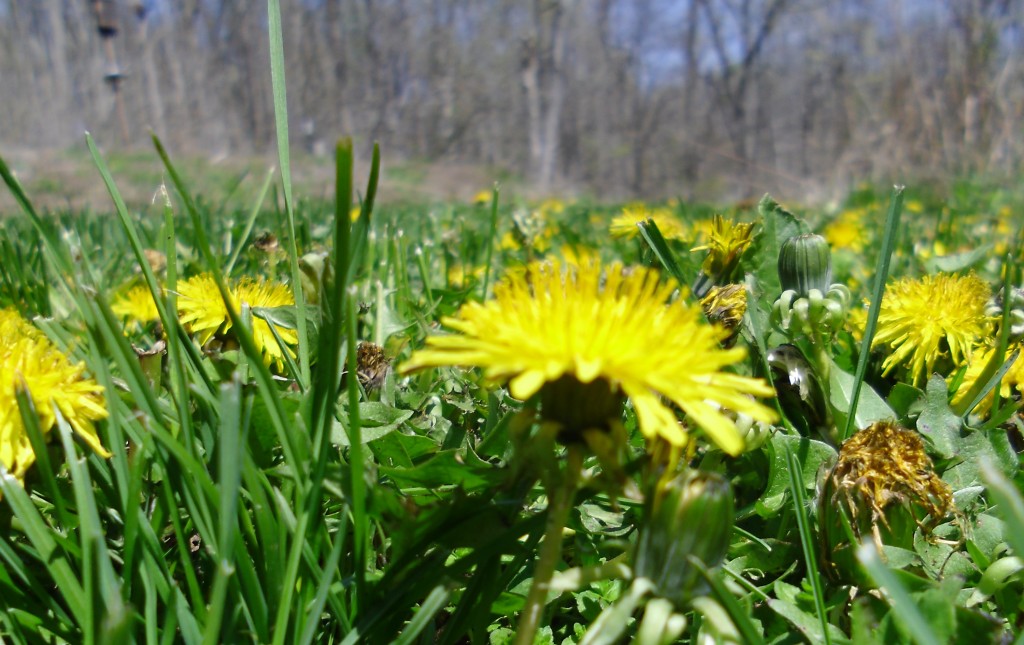
Dandelion
It would be a shame not to include a ‘shout out’ to nutrient rich, liver loving dandelion—which is plentiful…errr…everywhere. Pausing to laugh as I think about visually describing this beautiful, well-known plant. Spanning across all of the United States, only backing down from a lush spread when it reaches the most northern stretches of Canada—is there really such a thing as unfamiliarity with dandelion?? Ha! Still, here’s a little visual mosaic;
Surviving for two or more winters, dandelion is a perennial. Most people are more familiar with its second year growth. During this stage, the leaves grow quickly—nourished by deep, nutrient amassing roots and watered by spring rains and melting snow. The amount of leaves on each plant, as well as their size, depend on the size of the root. The leaves, toothed and variably lobed, sport interesting irregularity, causing occasional confusion with other similar-looking plants, such as cat’s ear and chicory. All three of these plants (cat’s ear, chicory and dandelion) are edible, yet to tell them apart, check out the ‘hair factor.’ If you look closely at the leaves, you’ll notice that dandelion is virtually hairless on both sides. Chicory is hairy along the mid-vein on the back side of the leaf. The hair on a cat’s ear leaf can be easily seen and felt, on both sides.
What looks like one dandelion flower is really a cluster of flowers—a composite flower, or a flower head. Each yellow petal is actually the tip of a separate flower. Each flower forms a single seed on the seed head. Eventually, this flower cluster transforms into the beautiful, white ‘puffball’ seed head that generates hours and hours of seed-blowing fun.
While all parts of dandelion are edible, the flavor depends much on the growing conditions and the stage of growth. Many wild food enthusiasts give the impression that all wild food is delicious, regardless of when or where it is collected or how it is prepared. This can be misleading and make for an less than enjoyable dining experience for those who have little practical experience. Dandelion is bitter! There are very few ways of getting around this, and while I’ve grown fond of its bitter qualities, I usually stick to collecting leaves during the early spring—when the plants are less bitter—AND gathering the younger, lighter green leaves.
One of the best ways that I’ve found to get past the intense flavor is to pair the leaves with other foods. If I am steaming or sautéing, I will cook dandelion with other veggies. In a salad, I like to pair darker greens with lighter, less intense lettuce greens. My favorite, and typical way of eating dandelion, however, is blended into a green smoothie—with other greens, non-sweet and/or a small amount of sweet fruit. I rarely notice the bitter flavor at all eaten this way…and, as I already mentioned above, have grown to enjoy the bitterness when it shines through.
Dandelion roots can be added to soups or used to make herbal infusions. Admittedly, I prefer the greens and have little experience with the roots.
Dandelion and other bitter greens assist digestion. Ingesting the leaves increases hydrochloric acid in the stomach, sends a message to the liver to prepare for digestion, increases the appetite and helps to prepare the liver for breaking down fats. For all of these functions, the more bitter the better. If improving digestion (which most of us could benefit from) isn’t grand enough, dandelion also increases circulation and helps fluid waste elimination in the body (without depleting the body of nutrients in the process). Dandelion is high in carotene, vitamin C, potassium, calcium, iron, the B vitamin spectrum and protein.
With uses and applications that are only limited by imagination, dandelion is a common and versatile plant, offering dense nutrition at every stage.
Dandelion and Sunchoke Soup
(4-6 servings)
1 cup chopped dandelion roots
3-4 cups chopped sunchokes
2 cups dandelion leaves
2 cups diced onions
1/2 cup washed and shredded dulse (or any other sea veggie)
2 (or more) garlic cloves
Cook dandelion root and sunchokes in enough water to cover. Sauté onion, dandelion leaves, dulse and garlic cloves in a bit of ghee or coconut oil. When the sunchokes and roots are tender, add the sautéed mixture to the soup and season with sea salt and pepper to taste. (Can blend for a thick, creamy soup, or eat as is.)
Simple Dandelion Salad with Herb Dressing
(4-6 servings)
salad:
4 cups dandelion greens, washed and torn into bite~size pieces
4 cups lettuce leaves (any lettuce)
1/2 onion, diced
2 hard boiled eggs from healthy, happy, pastured hens (sliced)
dressing:
4 tablespoons hemp or olive oil
4 tablespoons lemon juice
2 tablespoons fresh herbs of choice
sea salt, to taste
Blend dressing ingredients in high speed blender, or finely chop herbs and shake together. Combine all ingredients in a large bowl. (Can garnish with edible flowers.)
Dandelion Dream (Green Smoothie)
(4 servings)
4 cups dandelion greens, washed and torn
2 oranges
2 cups spinach
1 cup hemp or coconut milk
1/2 lemon, peeled
1-2 dropperfuls of vanilla stevia
Blend until smooth—and Enjoy!